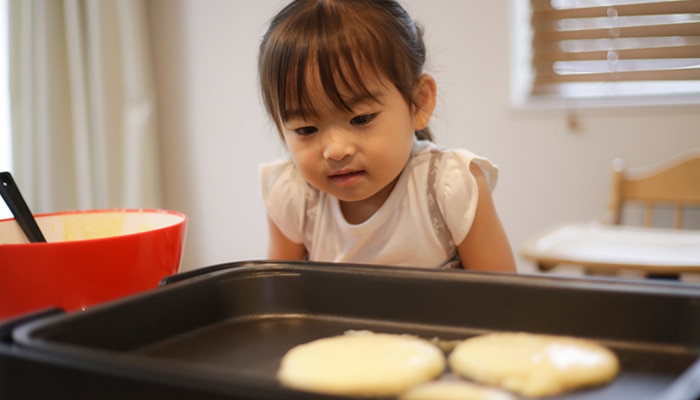While we believe that the books and resources recommended may be of value to you, keep in mind that these are suggestions only and you must do your own due diligence to determine whether the materials are appropriate and suitable for your use. PNC has no sponsorship or endorsement agreement with the authors or publishers of the materials listed.
THEME

From a Liquid to a Solid - Making Pancakes
Children will investigate changing states of matter using some foods that come from farms.

Lesson Objective
Children will investigate changing states of matter as they make pancakes, which contain foods that come from farms.
Science
What You'll Need
Note: See Lesson Tips
- Book: Pancakes, Pancakes by Eric Carle
- 1½ cups flour
- 1 egg
- 1¼ cups milk
- 1 tsp. salt
- 1 tbsp. sugar
- 3½ tsp. baking powder
- 3 tbsp. melted butter
- Electric frying pan
- Measuring cups and spoons
- Cooking spray
- Mixing bowl
- Spoon
- Pancake turner
- Butter
- Small plates – 1 per child
- Plastic forks– 1 per child
What To Do
- Ask the children where they think food comes from (see Guiding Student Inquiry).
- Introduce the story, Pancakes, Pancakes, by Eric Carle. Tell the children that it is a story about a boy who wants a giant pancake for breakfast and needs to find the ingredients.
- Read the story to the children.
- Focus on each of the ingredients for the pancakes in the story and where they come from.
- At the end of the story, have the children recall where each of the ingredients came from.
- Ask children where they think wheat grows and where chickens and cows can be found (see Guiding Student Inquiry).
- Tell the children that they will be investigating changes from liquid to solid by making pancakes using some of the same ingredients they learned about in the book (see Lesson Tips).
- Display and discuss characteristics of each ingredient.
- Invite the children help to measure the ingredients into the bowl, and have the children take turns using the spoon to mix the pancake batter. Discuss the changes as the dry ingredients are mixed with the liquids (see Guiding Student Inquiry).
- Spray the electric frying pan with cooking spray, and heat it at a medium setting, away from the children.
- Pour batter in 3" puddles into the hot pan. Turn the pancakes over when the batter has bubbled and the edges look dry.
- When pancakes are lightly browned, remove from pan, and place pancakes on plates.
- Distribute plates of pancakes to the children, and discuss how the batter changed (see Guiding Student Inquiry).
- Distribute the forks and butter to the children, and enjoy the pancakes as a snack.
Resources
Home School Resources
Home educators: use these printable lesson PDFs to teach this lesson to your home schoolers. They're available in English and Spanish.
Content Provided By
Common Core State Standards Initiative – These lessons are aligned with the Common Core State Standards ("CCSS"). The CCSS provide a consistent, clear understanding of the concepts and skills children are expected to learn and guide teachers to provide their students with opportunities to gain these important skills and foundational knowledge [1]. Visit the CCSS


